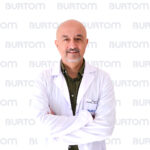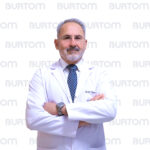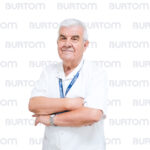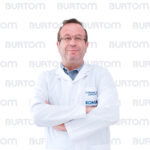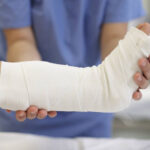Burtom ‣ Departments ‣ Orthopedics and Traumatology
Language: 🇬🇧 English | 🇹🇷 Türkçe

Orthopedics and Traumatology Department Overview

The Orthopedics and Traumatology Department specializes in the diagnosis, treatment, and management of musculoskeletal conditions and injuries. This encompasses disorders of bones, joints, muscles, ligaments, and related structures. Orthopedic and trauma specialists employ surgical and non-surgical interventions to restore function, alleviate pain, and enhance mobility. The department plays a crucial role in providing comprehensive care for patients with orthopedic issues, ranging from degenerative conditions to traumatic injuries, promoting musculoskeletal health and overall well-being.
Key Functions of an Orthopedics and Traumatology

The key functions of an Orthopedics and Traumatology Department include:
Diagnosis and Evaluation: Accurate assessment and diagnosis of musculoskeletal conditions through clinical evaluations, imaging studies, and diagnostic tests.
Non-Surgical Treatment: Implementing non-surgical interventions such as medications, physical therapy, and rehabilitation to manage and alleviate orthopedic and traumatic conditions.
Surgical Interventions: Performing a wide range of orthopedic surgeries, including joint replacement, arthroscopy, fracture fixation, and spinal procedures, when necessary for optimal outcomes.
Trauma Care: Providing specialized care for traumatic injuries, including fractures, dislocations, and soft tissue injuries, with a focus on rapid and effective treatment.
Joint Preservation: Employing strategies to preserve joint function, prevent degeneration, and delay the need for joint replacement whenever possible.
Sports Medicine: Addressing sports-related injuries, optimizing athletes’ performance, and facilitating their safe return to sports activities.
Pediatric Orthopedics: Specialized care for children with orthopedic conditions, ensuring appropriate growth and development of the musculoskeletal system.
Rehabilitation Services: Collaborating with rehabilitation specialists to provide comprehensive post-operative and post-injury rehabilitation programs.
Pain Management: Implementing strategies to manage and alleviate pain associated with musculoskeletal conditions, utilizing both pharmacological and non-pharmacological approaches.
Orthopedic Oncology: Managing and treating musculoskeletal tumors, working closely with oncologists to provide comprehensive care.
Orthopedic Imaging: Utilizing advanced imaging techniques, such as X-rays, MRI, and CT scans, for precise diagnosis and treatment planning.
Orthopedic Research: Engaging in research activities to advance orthopedic knowledge, improve treatment outcomes, and contribute to scientific advancements.
Patient Education: Providing patients with comprehensive education about their conditions, treatment options, and self-care measures to empower them in the management of their musculoskeletal health.
Orthopedic Emergency Care: Offering prompt and specialized care for orthopedic emergencies, including fractures, joint dislocations, and severe soft tissue injuries.
Collaboration with Multidisciplinary Teams: Collaborating with other healthcare professionals, including physical therapists, radiologists, rheumatologists, and pain management specialists, to ensure holistic patient care.
Prosthetics and Orthotics: Providing and fitting patients with prosthetic devices and orthotic supports to enhance mobility and function.
Preventive Care: Implementing preventive measures and lifestyle modifications to minimize the risk of musculoskeletal conditions and injuries.
These key functions collectively contribute to the Orthopedics and Traumatology Department’s mission to deliver comprehensive, patient-centered care, addressing a wide spectrum of musculoskeletal issues and traumatic injuries.
Situations within the scope of Orthopedics and Traumatology

Situations within the scope of Orthopedics and Traumatology include a diverse range of musculoskeletal conditions, injuries, and disorders. Here are some specific situations commonly addressed by professionals in this field:
Fractures and Dislocations: Management and treatment of bone fractures and joint dislocations resulting from trauma or accidents.
Joint and Soft Tissue Injuries: Evaluation and care for injuries to joints, ligaments, tendons, and muscles, including sports-related injuries.
Arthritis and Joint Degeneration: Diagnosis and management of arthritis, osteoarthritis, and other degenerative joint conditions affecting mobility and function.
Spinal Disorders: Treatment of spinal conditions, such as herniated discs, spinal stenosis, and degenerative disc disease.
Orthopedic Oncology: Care for musculoskeletal tumors, involving the diagnosis and treatment of bone and soft tissue cancers.
Congenital Orthopedic Conditions: Evaluation and treatment of musculoskeletal abnormalities present at birth, including congenital hip dysplasia or clubfoot.
Sports-Related Injuries: Assessment and care for injuries sustained during sports activities, ranging from sprains and strains to more complex conditions.
Pediatric Orthopedics: Specialized care for children with musculoskeletal conditions, growth abnormalities, and developmental disorders.
Orthopedic Infections: Diagnosis and management of infections affecting bones and joints, including osteomyelitis and septic arthritis.
Degenerative Joint Diseases: Treatment of conditions like osteoarthritis and rheumatoid arthritis, which impact joint health and function.
Orthopedic Trauma: Urgent care and surgical intervention for severe musculoskeletal injuries resulting from accidents, falls, or trauma.
Orthopedic Emergencies: Immediate response to emergencies such as fractures, dislocations, or open fractures requiring urgent attention.
Limb Length Discrepancies: Evaluation and management of conditions causing differences in limb lengths, including interventions like limb lengthening procedures.
Orthopedic Deformities: Correction of skeletal deformities, such as scoliosis, clubfoot, or limb deformities due to various causes.
Orthopedic Rehabilitation: Collaborative rehabilitation programs for post-surgical recovery, injury rehabilitation, and mobility restoration.
Rheumatologic Disorders: Management of rheumatologic conditions affecting the musculoskeletal system, such as lupus or ankylosing spondylitis.
Orthopedic Neurological Disorders: Care for conditions where neurological issues impact musculoskeletal function, like peripheral nerve injuries or spinal cord disorders.
Orthopedic Metabolic Disorders: Diagnosis and treatment of metabolic bone disorders, including osteoporosis and Paget’s disease.
These situations highlight the breadth of Orthopedics and Traumatology, covering a wide spectrum of musculoskeletal issues that impact patients’ mobility, function, and overall quality of life. Professionals in this field work to address these diverse situations through a combination of medical, surgical, and rehabilitative interventions.
Patient Experience in the Orthopedics and Traumatology

The patient experience in Orthopedics and Traumatology involves a comprehensive and patient-centered approach to addressing musculoskeletal conditions and traumatic injuries. Here are key aspects of the patient experience in this field:
Initial Evaluation: Patients undergo a thorough initial evaluation, including a detailed medical history and physical examination, to assess the nature and extent of their musculoskeletal condition or injury.
Diagnostic Imaging: Utilization of diagnostic imaging techniques such as X-rays, MRI, and CT scans to aid in precise diagnosis and treatment planning.
Clear Communication: Effective and clear communication between healthcare professionals and patients, ensuring a mutual understanding of the diagnosis, treatment options, and expected outcomes.
Individualized Treatment Plans: Development of individualized treatment plans based on the specific needs and goals of each patient, taking into consideration factors like age, lifestyle, and overall health.
Non-Surgical Options: Exploration of non-surgical interventions, such as physical therapy, medications, and lifestyle modifications, before considering surgical options.
Surgical Consultation: Transparent discussions about surgical interventions if necessary, including explanations of the procedure, potential risks, and expected recovery.
Preoperative Education: Thorough preoperative education for patients scheduled for surgery, providing information about pre-surgical preparations, postoperative care, and rehabilitation.
Pain Management: Implementation of effective pain management strategies to alleviate discomfort associated with musculoskeletal conditions or postoperative recovery.
Rehabilitation and Physical Therapy: Integration of rehabilitation and physical therapy into the overall treatment plan, promoting recovery, improving mobility, and preventing further complications.
Orthopedic Nursing Care: Supportive and specialized nursing care for patients admitted to orthopedic wards or undergoing surgical procedures.
Postoperative Follow-up: Regular postoperative follow-up appointments to monitor progress, address concerns, and adjust treatment plans as needed.
Mobility Assistance: Provision of assistive devices or mobility aids when necessary, ensuring patients can navigate their environment safely.
Emotional Support: Emotional support throughout the treatment process, recognizing the impact of musculoskeletal conditions on a patient’s overall well-being.
Patient Empowerment: Empowering patients with information and resources to actively participate in their recovery, fostering a sense of control over their health.
Coordination of Care: Seamless coordination of care among various healthcare professionals, including orthopedic surgeons, physical therapists, nurses, and rehabilitation specialists.
Education on Home Care: Providing detailed instructions and education on at-home care, including wound care, medication management, and exercises for continued recovery.
Postoperative Rehabilitation: Guidance and supervision during the postoperative rehabilitation phase, ensuring patients regain strength, flexibility, and function.
Long-Term Follow-up: Long-term follow-up care to monitor for any potential complications, address ongoing concerns, and promote sustained musculoskeletal health.
The patient experience in Orthopedics and Traumatology is characterized by a multidisciplinary and collaborative approach, aiming to improve patients’ quality of life by addressing musculoskeletal issues with personalized, compassionate care.
Conclusion

In conclusion, Orthopedics and Traumatology play a pivotal role in enhancing the lives of individuals by addressing a wide spectrum of musculoskeletal conditions and traumatic injuries. The comprehensive patient experience in this field reflects a commitment to personalized, evidence-based care that encompasses diagnostics, treatment options, and rehabilitation.
Orthopedic and trauma specialists strive to deliver clear and empathetic communication, ensuring that patients are well-informed about their conditions and involved in decision-making processes. The emphasis on individualized treatment plans, ranging from non-surgical interventions to complex surgical procedures, reflects a commitment to tailoring care to meet the unique needs of each patient.
The integration of rehabilitation, physical therapy, and postoperative follow-up underscores the holistic approach to musculoskeletal health. By addressing pain, promoting mobility, and fostering patient empowerment, the field contributes not only to the resolution of immediate concerns but also to the long-term well-being of individuals.
Through collaboration with other healthcare professionals and a dedication to ongoing research and education, Orthopedics and Traumatology continually evolve to incorporate the latest advancements in the field. This ensures that patients receive the most effective and innovative care, contributing to improved outcomes and quality of life.
In essence, the patient experience in Orthopedics and Traumatology reflects a commitment to excellence, compassion, and the restoration of musculoskeletal health, allowing individuals to regain functionality and resume their daily activities with confidence and independence.
Medical Devices Used in the Orthopedics and Traumatology

Orthopedics and Traumatology utilize a variety of medical devices to diagnose, treat, and manage musculoskeletal conditions and traumatic injuries. Here are some common medical devices used in this field:
X-ray Machines: Essential for imaging bones and joints, aiding in the diagnosis of fractures, dislocations, and other skeletal abnormalities.
Computed Tomography (CT) Scanners: Provides detailed cross-sectional images of bones and soft tissues, assisting in the evaluation of complex fractures and trauma.
Magnetic Resonance Imaging (MRI) Machines: Produces detailed images of soft tissues, ligaments, and joints, aiding in the diagnosis of conditions such as ligament tears and joint injuries.
Arthroscopy Instruments: Specialized instruments for minimally invasive arthroscopic procedures to visualize and treat joint conditions, including repairs to ligaments and cartilage.
Orthopedic Implants: Various implants such as plates, screws, nails, and joint prostheses used for fracture fixation, joint replacement, and stabilization of bones.
Bone Densitometers: Measures bone density to assess the risk of fractures and diagnose conditions like osteoporosis.
Ultrasound Machines: Used for imaging soft tissues, tendons, and muscles, particularly in sports medicine and musculoskeletal ultrasound.
Electromyography (EMG) Devices: Measures electrical activity in muscles and nerves, aiding in the diagnosis of neuromuscular disorders.
C-Arm Fluoroscopy: Provides real-time X-ray imaging during surgical procedures, enabling precise guidance for orthopedic surgeries.
Orthopedic Power Tools: Surgical tools such as drills, saws, and reamers used for bone shaping, cutting, and preparation during orthopedic surgeries.
External Fixation Devices: Utilized for stabilizing fractures externally, typically in cases of severe trauma or open fractures.
Orthotic and Prosthetic Devices: Custom devices designed to support, align, or replace parts of the musculoskeletal system, including braces, splints, and artificial limbs.
Gait Analysis Systems: Used to assess and analyze a patient’s walking pattern and posture, providing valuable information for orthopedic and rehabilitation planning.
Pulse Lavage Systems: Devices for wound irrigation during orthopedic surgeries, helping to reduce infection risk.
Traction Devices: Mechanical devices that apply controlled force to bones or joints, commonly used in the treatment of fractures or spinal conditions.
Pressure Mapping Systems: Measures pressure distribution on surfaces, helpful in designing orthopedic supports and cushions for pressure ulcer prevention.
Bone Growth Stimulators: Devices that use electromagnetic fields or ultrasound to promote bone healing, particularly in cases of non-union fractures.
Portable X-ray Machines: Compact devices for on-site or emergency imaging, useful in situations where traditional X-ray rooms are not available.
These medical devices play a crucial role in the diagnosis, treatment, and ongoing management of orthopedic and traumatological conditions, contributing to improved patient outcomes and quality of life.
Doctors and Medical Staff

Get a Free Second Opinion
Experienced Burtom Medical Team is Ready to Help

I consent to Burtom Health Group using my aforesaid personal data for the purposes described in this notice and understand that I can withdraw my consent at any time by sending a request to info@burtom.com.

